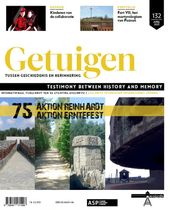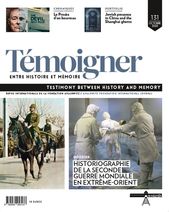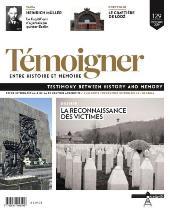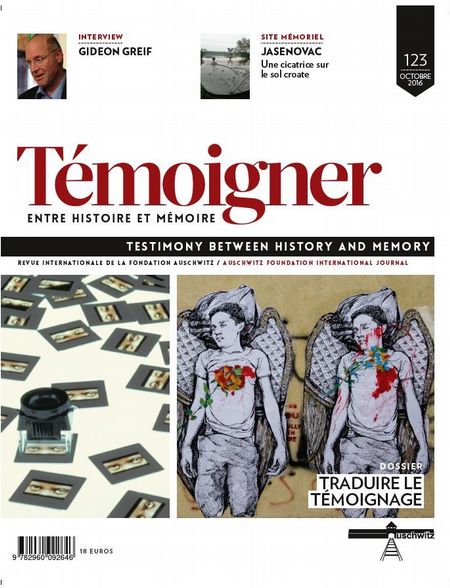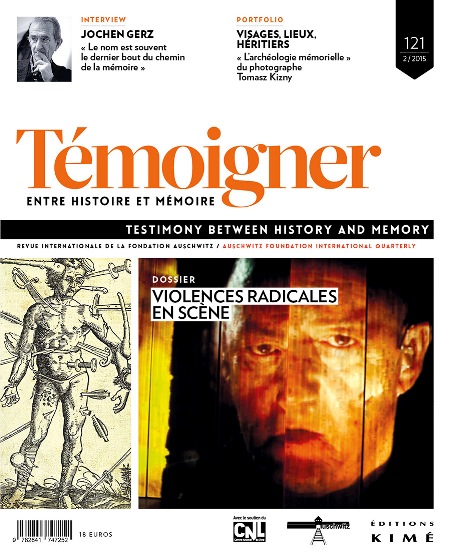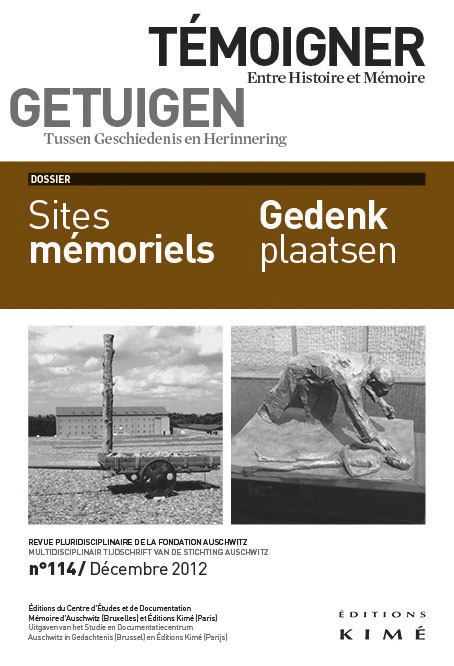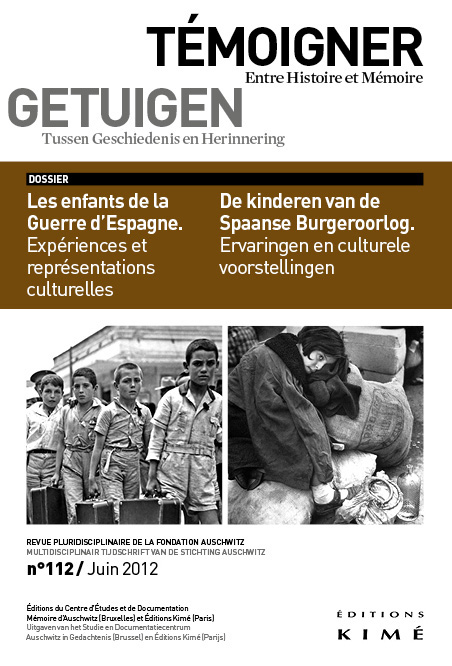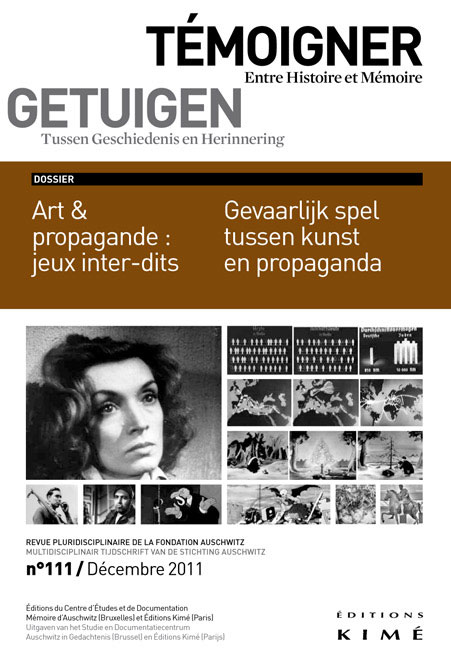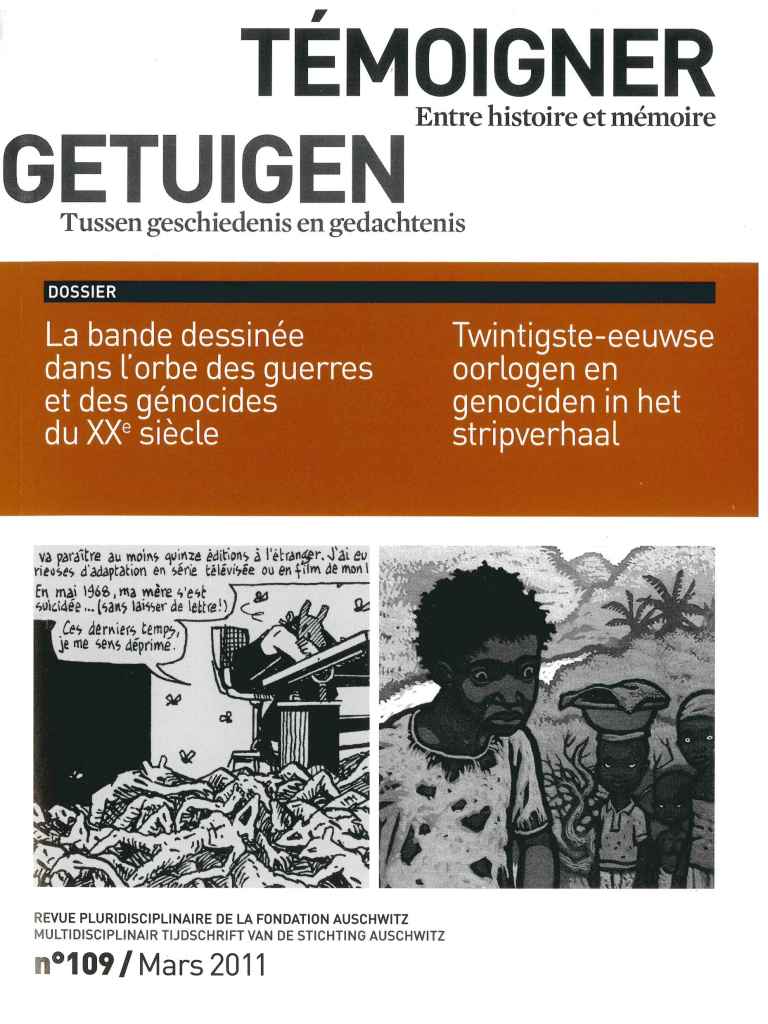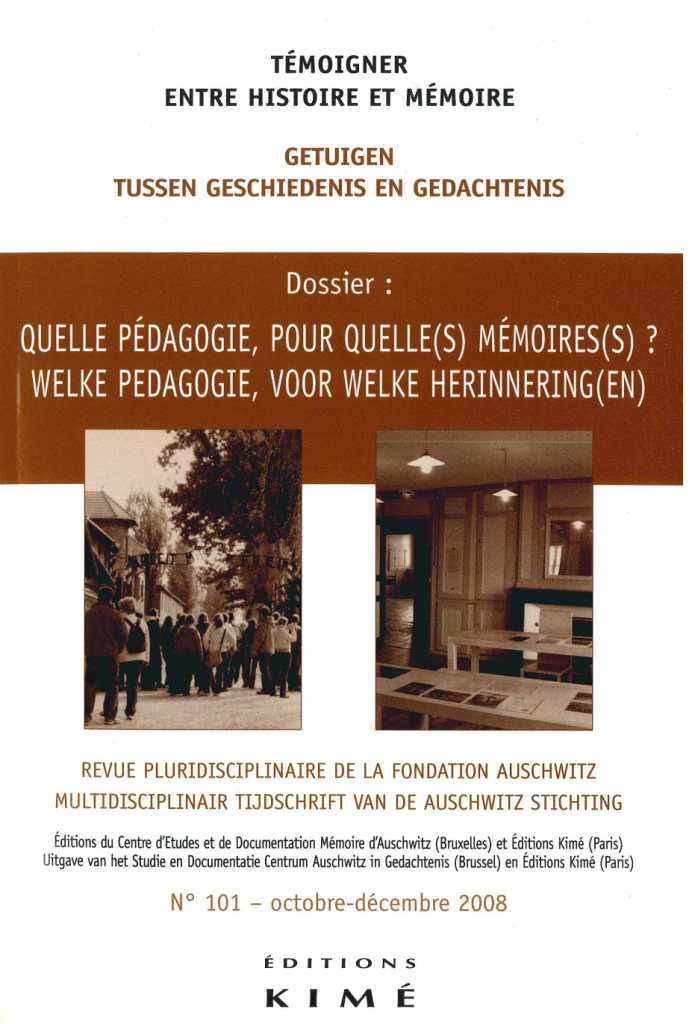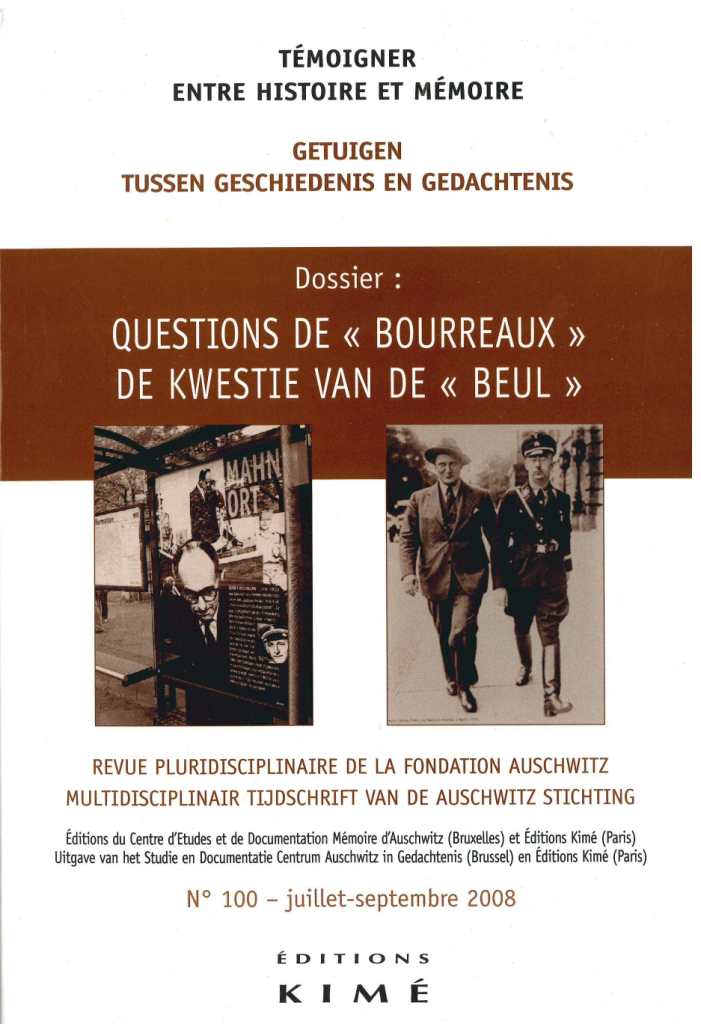Summary, abstract and full texts n° 102
Dossier: Criminels politiques en représentation. Arts, cinéma, théâtre, littérature, médias
Coordinated by Philippe Mesnard and Yannis Thanassekos
Philippe Mesnard: Editorial (pdf in French)(pdf in Dutch)
Literature
Albert Mingelgrün: La figure du bourreau nazi au tournant du XXIe siècle : quelques variations littéraires (pdf) [The figure of the Nazi killer at the turning-point of the 21st. century: some literary variations]
- In light of the importance during recent years - at least numerically - of publications dealing with the figure of the Nazi killer, both fiction and in historical examinations of the question, as compared with the relatively low number of similar publications in earlier years, I have tried to question the meaning of this disparity by examining a representative sample of these publications, particularly various examples of fiction inspired by the Nazi killer. Pascal spoke of putting illnesses to good use; to paraphrase that expression, the study offered here, which is, of course, far from exhaustive, simply aims to examine the putting of remembrance to good - or bad - use...
Anneleen Spiessens: La mise en scène du bourreau. Jean Hatzfeld et Gilbert Gatore (pdf)
- This article deals with two books on the Rwandan genocide, Une saison de machettes [A Time for Machettes] by Jean Hatzfeld, and Le passé devant soi by Gilbert Gatore. To bear witness to that tragic period and describe the extreme violence of the massacres, the two authors have adopted a literary and even a fictional approach. Moreover, they have not hesitated to let the persecutor have his say. We examine the way in which the killer is presented in these books from two angles. Firstly, we analyse the specific nature of what the persecutor says, his attitude to remembrance and truth and the difficulties inherent to his testimony. We go on to evoke the persecutor as a literary personage by analysing the narrative procedures used and the author’s position in the narrative.
Charlotte Lacoste: Fiction, diction et génocide (pdf)
- Literature viewed as a (prestigious) means of producing falsehoods (fiction) and/or fine style (diction) has shown itself throughout the twentieth century to be a favourable means for falsifying history, notably the history of wars and genocides. An analysis of a novel which recently won a French literary prize, Le passé devant soi by Gilbert Gatore (2008), whose background is the genocide of the Tutsi of Rwanda and which deals with the incomparable suffering of... a perpetrator of genocide, shows that the business of revisionism in literature is still flourishing.
Georges Tyras: Rafael Sánchez Mazas ou la sale mine du « récit réel » (sur Les soldats de Salamine, de Javier Cercas) (pdf) [Rafael Sánchez Mazas or the "sale mine" [dirty mine] of the "true story" (on Les Soldats de Salamine by Javier Cercas)]
- 70 years after the end of the Spanish Civil War, it is unusual for Spanish literature to depict a character from the victors’ camp. In Les Soldats de Salamine, Javier Cercas takes as the protagonist of his novel a notorious member of the clan of Civil War victors, co-founder of the Falange and author of innumerable articles and speeches lauding the merits of Franco’s regime. But does this rich aristocrat, who was more attracted by writing than by action, impose himself as the hero of the book Cercas devotes to him? An analysis of his portrait in the novel, and that of the exiled Republican Miralles which is intended to counter-balance him in the last part of the novel, shows that this is not the case. Super-imposed on the figures of Sánchez Mazas and Miralles to such a point that they almost cover them, the imposing silhouette of the narrator and his work of investigation and writing become the novel’s real protagonists. By lessening and overriding the text’s moral significance, its literary dimension impels a triple response, to its narrative structure, its literary technique and the characters of the novel. Les Soldats de Salamine advance masked.
Cinema
Nancy Berthier: De Franco ese hombre de José Luis Sáenz de Heredia à Caudillo de Basilio Martín Patino, une histoire de détails
- A few years before Franco’s death, the film-maker Basilio Martin Patino secretly put together Caudillo, a biography of the head of state using existing film. This full-length film marks a turning-point in the history of representations of Franco, as for the first time in the history of Spanish cinema it offers an alternative, even dissident, version of the General’s biography. Patino builds up the narrative of his film on an aesthetic of detail, using both visual and audio montage to take apart from the inside the narrative methods of Franco’s propaganda, as they are expressed in the propaganda film produced in 1964 by José Luis Sáenz de Heredia, Franco ese hombre [That man Franco]. Apart from its pioneering character, the interest of Caudillo lies in the fact that it takes the enemy’s own weapons in order to turn them against him. The essence of the film lies in its details, which form part of an aesthetic of subversion.
- Must the cinema inevitably portray Nazi criminals as caricatures? This article attempts to provide some answers to this question by referring to a certain number of fictional films which offer more or less well documented and convincing portrayals of Nazi criminals, and also questions the strange complicity which the cinema continues to maintain with these sinister characters. The analysis focuses in particular on Hitler Beast of Berlin (Sam Newfield, 1939), one of the first American films to be set in a German concentration camp, and Andrzej Munk’s famous film The Passenger (1963).
Theatre
Annick Asso: La mise en scène des bourreaux dans L’instruction de Peter Weiss (pdf)
- In his play The Investigation, created in 1965, Peter Weiss combines a documentary approach to theatre with the form of the oratorio to bring the victims of Auschwitz face to face with their persecutors. Using the records of the 1964 Frankfurt Auschwitz trial, the playwright describes the extermination process from arrival at the camp to the gas chambers. 19 Auschwitz persecutors appear on stage to answer for their crimes. In the theatre Peter Weiss uses the technique of "black and white", so as to leave no possible margin of error in the final interpretation of the actions on trial. The play does not have an ending, in that it is for the spectator to formulate the final verdict. Moreover, at the end of the play another problem is raised in addition to the question of the persecutors’ obvious guilt. Peter Weiss questions how their acts should be qualified, bearing in mind that only accusations of murder were judged at Frankfurt, as well as what legal instruments should be developed to judge the crime of genocide.
- In the theatre, a persecutor appears as part of a couple, his role being to arouse an appropriate reaction. First and foremost, the persecutor offers a foil and a contrast to the portrayal of the victim, provoking both the horror and indignation of the audience and greater compassion for the victim, even admiration for the way in which he confronts the suffering inflicted on him. The theatre from the end of the sixteenth and beginning of the seventeenth centuries aids our understanding of this process.
Artists
Patrick Javault: Double portée [Double meaning]
- By equipping five of his famous anthropomorphic cats with Hitler’s forelock and moustache, Alain Séchas has apparently taken up the banner of the politically committed artist. A closer examination should convince us that what is involved in "Spoiled Children" is less the denunciation of neo-Nazism than a serious reflection on the relationships between form and formation, between the creative act and its meaning.
Jean-Marc Cerino: Carré brun sur fond blanc
Comics
Catherine Ojalvo: Figures et dess(e)in du bourreau khmer rouge dans les œuvres de Séra (pdf) [Figures and designs of Khmer Rouge killers in the works of Séra]
- Can the comic book, considered a priori as a "minor art", support and assume the role of testimony on the same level as the texts produced by Antelme, Kertesz or Levi? It is the validity of this question, focusing more particularly on how persecutors are depicted, which we propose to consider in this contribution, by examining the productions of Séra, a Franco-Cambodian author of comic books who is also a painter and sculptor. We look at two excerpts from the three comic books which together form a sequence describing different periods of the Khmer Rouge regime in Cambodia. How can the Khmer Rouge killers be portrayed: what do we see of them, their gestures, their bodies, their victims, in the precise strokes of the illustrator Séra? Another (new?) level of perception then opens for the reader of these images which tell a story: something to do with the absolutism of the acts carried out by the killers, aspects which we are able to see although we never should or could have been able to perceive them…
Medias
Claudia Feld: Entre visibilité et justice : les témoignages télévisuels des ex-agents de la répression en Argentine [Between visibility and justice: Television testimony by former agents of repression in Argentina]
- This article concerns statements by former agents of repression (represores) linked to the disappearances during Argentina’s last military dictatorship (1976-1983). In 1995 Argentine television stations asked the persecutors, who had not been punished, to testify on television concerning their participation in the repression. This raised expectations among their victims and society in general that they would tell the truth and display repentance. In general these expectations were not fulfilled - the persecutors made negationist statements or declared that under the same conditions they would behave in exactly the same way - but the programmes nevertheless managed to present their statements as confessions and repentance. However, their statements and the facts they contained led to the opening of a breach in the silence which had taken hold of gripped society and the impunity enjoyed by these same agents of repression. This article examines the way in which these testimonies were presented on television and the remembrance and ethical issues relating to these statements.
Robert N. Kraft: Considérations sur les témoignages des criminels : comment les commissions vérités contribuent au genre des témoignages filmés (pdf) [Reflections on testimony from criminals: how truth commissions contribute towards testimony on film]
- The majority of testimony on film which has been collected and catalogued in audiovisual archives is from people who have been persecuted. Obviously, it is usually difficult to persuade criminals to make admissions. However, thanks to the "truth commissions" set up with a view to resolving national conflicts (like those held successfully in South Africa from 1995 to 2001), detailed and freely given confessions have been recorded in exchange for an amnesty for the crimes committed. These confessions, which could not have been obtained in any other way, are likely to lead to a fuller understanding not only of the crimes, but also of the criminals themselves.
Filmography
Vincent Lowy and Bruno Della Pietra: Bourreaux et tortionnaires à l’écran. Petite filmographie (pdf)
Other subjects
Daniel Weyssow: « À la recherche du père é-perdu ». Texte-dessins de Sarah Kaliski (pdf text)(pdf images)
Contact
Auschwitz Foundation – Remembrance of Auschwitz
Rue aux Laines 17 box 50 – B-1000 Brussels +32 (0)2 512 79 98
+32 (0)2 512 79 98 info@auschwitz.be
info@auschwitz.be
BCE/KBO Auschwitz Foundation: 0876787354
BCE/KBO Remembrance of Auschwitz: 0420667323
Office open from Monday to Friday 9:30am to 4:30pm.
Visit only by appointment.
![]()
![]()
![]()
![]()
![]()
Become a member
To become a member of Remembrance of Auschwitz ASBL, please contact us and transfer the sum of €50.00 to our account IBAN: BE55 3100 7805 1744 – BIC: BBRUBEBB with the communication: ‘Membership fee 2025’. The membership includes two issues of 2025 of our scientific journal.
DONATIONS
Donations of €40.00 or more (in one or more instalments) qualify for tax exemption for Belgian taxpayers.
In communication, please specify that it is a ‘Donation’ and mention your National Number which is required since 2024 to benefit from the tax exemption.
Subscribe
Error : Please select some lists in your AcyMailing module configuration for the field "Automatically subscribe to" and make sure the selected lists are enabled









